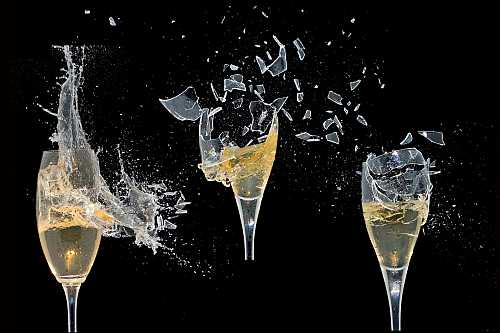DIY – High Speed Photography at Home
by
How to take photos like the one you are seeing here. It’s a glass of Champaign, being shot with a BB gun. You can use this technique to take picture of exploding things like tomatoes, watter balloons, watermelons, or even you Canon camera as you smash it against a wall for not understanding the menus (Sorry, could not resist…)
Freezing fast motion (AKA High Speed Photography), can give some pretty special photographic effects. High Speed Photography is used in physics, health research, sports and more. This guide describes how to capture super fast movements using ordinary camera gear and a little
Here is a nice example of High Speed Photography:
Capturing a balloon just as it punctures

Nuking an apple

Capturing such images introduces a lot of challenges. How does one handle timing with exposures times
faster than 1/6000 second!?
We have to handle shutter lag, synchronize the flash and time the exposure to just the right moment.
But the shutter lag of any normal camera is so long that it will be all most impossible to time the exposures. And how do you synchronize the flash with an exposure time of less than 1/6000 second?
To work around the problems with shutter lag and flash synchronization, the exposure is done in a completely dark room. This way the shutter can opened without actually getting an exposure. The exposure time set on the camera just has to be long enough for the action to happen while the shutter is still open. Because the room is dark, the long exposure time will not have any effect on the final output (this is because no light enters the lens to hit the sensor / film)
To actually get an “exposure”, a flash is fired. The flash light duration will now become the actual
exposure time.
SO now we need to see how long does it takes the flash to fire. It turns out that the output power of the flash, actually affects the duration of the light, so to get exposure times. If you need exposure faster than 1/6000 seconds, the output needs to be reduced. For more information on the light duration please see the test I ran on my Sigma EF-500 flash.
Now we only need to synchronize the flash with the action we want to capture.
This can be done in several ways. For example synchronizing with a balloon puncture, can be done via sound. Impact-actions, like a BB Soft air gun pellets, can be triggered with a mechanical switch, like in the picture below. When the pellet hits the cd-cover it’s pushed on to the switch, which then triggers the flash.

Here is my High Speed Photography setup and work flow (Balloon Shot).
The Gear:
- Balloon (OK – we are going to nuke this one, so don’t use your favorite)
- Digicam
- Tripod
- Sigma Flash
- Home made sound trigger (more info). If you do not have an optical slave you can use the Universal Sound Slave Circuit
- Needle (or BB-gun, see below)
- Backdrop (I use a black Bristol sheet)
The Setup
First step is to set-up the scene. The black Bristol sheet is used as backdrop. The balloon, flash, microphone
and camera are placed like in to image below

Gear settings:
- Flash: optical slave and 1/16 output power.
- Camera: Exposure time: 1-2 sec. ISO 100-200 Aperture F 11-16 manual focus.
- Microphone: The distance between the balloon and microphone, is used for synchronization. 50-70cm is good for balloon punctures 🙂
Next step is framing and focusing:
While trying to stay within the best performance on the lens, I
either zoom or move the tripod, until I have the desired framing. Focus
can be obtained either automatic or manual, but do remember to switch to
manual to lock focus, otherwise the camera will try to focus when the
lights are switched off.
Now it’s time to test the setup and lightning. All lights are switched off and the shutter is set to bulb.To fire the flash I just clap my hands. Then I review the image on the camera, checking for exposure, framing, focus and DOF.
To get the correct amount of light / exposure, one can Increase or decrease:
– the strobe distance to the balloon
– the output power of the flash
– the aperture on the camera
– ISO sensitivity on the camera
Taking the shot (pan intended :))
The test is repeated until satisfactory result have been reached, and the real photo can be taken. This is done the same way as when testing, but instead of clapping, the balloon is punctured with a needle.
One could also just fill the balloon with water and shoot it with a BB Soft air gun 🙂

This article was contributed by Karsten Stroemvig (aka Lullaby), see his other great high speed photograph projects
No comments:
Post a Comment
Note: Only a member of this blog may post a comment.